Niangling Maijiang Dianlang (Hordeolum / Stye)
Overview
In Miao-medicine, hordeolum is called Niangling Maijiang Dianlang. It is primarily caused by wind toxin. Traditional Chinese Medicine (TCM) believes that the condition arises from wind-heat attacking the eyelids, resulting in localized red, swollen nodules at the eyelash root, often filled with pus and resembling a grain of wheat.
In Western medicine, this condition is referred to as hordeolum or stye, which can affect the upper or lower eyelid. It frequently occurs in individuals with poor hygiene, weakened immunity, or chronic eye strain. It is considered an acute purulent inflammation.
Miao Medical Classification
This condition is classified as a minor disease in Miao-medicine.
Etiology
According to Miao-medicine, toxins are everywhere and varied. Wind toxin is highly mobile, easily invades the surface, and often carries other toxins. When bodily systems are weakened—such as poor qi and blood circulation, spleen-stomach weakness, or accumulated heat—wind toxin can invade and cause illness. This condition is most often triggered by wind toxin.
Pathogenesis
The invasion of wind-heat toxins impairs the circulation of qi and blood in the eyelids. Overconsumption of spicy food may cause internal heat that attacks the eyelids, leading to disharmony in the nutrient-defense system and resulting in stagnation. If residual toxins remain unresolved due to weak spleen-stomach function, recurrence is likely. Wind toxins typically affect the eyelid and eyelash follicles, leading to nodules, tenderness, and localized pus. If toxins invade deeper, systemic symptoms such as fever, thirst, and constipation may occur.

Diagnostic Points
Key Symptoms:
Red nodules at the eyelid margin or eyelash root, often the size of a soybean
Tender to touch, possibly accompanied by swollen lymph nodes behind the ears
Systemic signs: fever, dry mouth, constipation
Typically resolves in 3–5 days
Related Examinations:
Blood tests can help confirm inflammation
Differential Diagnosis
Galing Maipo Mong (Lacrimal Inflammation)
Both caused by wind toxin, but this type affects the lacrimal sac with symptoms like red, painful conjunctiva and continuous tearing. Niangling Maijiang Dianlang specifically causes nodules and pus at the eyelash root.
Niang Maixiang Lalai (Ulcerative Blepharitis)
Caused by wind, damp, and heat combined, with ulceration at the eyelid margin. Niangling Maijiang Dianlang is characterized instead by localized pustules at the root of eyelashes.
Syndrome Differentiation and Treatment
Symptoms:
Localized red nodule at the eyelid or eyelash root, soybean-sized, painful to touch, may be accompanied by fever, thirst, constipation, and enlarged lymph nodes. Course: 3–5 days.
Meridian Affiliation:
Belongs to heat meridian and hot-type diseases.
Treatment Principles:
Clear heat and detoxify (qingre jiedu)
Disperse wind and relieve heat (shusan fengre)
Recommended Herbal Prescription:
Chrysanthemum Flower (juhua) 15g
Dandelion (pugongying) 20g
Goldenrod Herb (yizhihuanghua) 15g
Gentian Root (longdancao) 20g
Herbal Functions:
Chrysanthemum Flower (juhua): cold, bitter; clears heat, relieves toxicity, disperses swelling
Dandelion (pugongying): cold, bitter; detoxifies, reduces abscesses
Goldenrod Herb (yizhihuanghua): cold, slightly toxic, disperses wind and heat, eliminates swelling
Gentian Root (longdancao): very cold, strongly bitter; clears liver fire, dries dampness, detoxifies
Preventive Measures
Maintain eyelid and facial hygiene
Avoid squeezing or rupturing the abscess
Do not incise before pus is evident
Follow a light diet; avoid spicy, greasy, and fried food
Commentary
In Miao medicine theory, illness is caused by “toxins, injuries, deficiencies, accumulation, microbes, parasites, disorder, and abnormalities.” Fundamentally, disease results from either toxins or internal imbalance. Poor hygiene or overconsumption of spicy foods can generate heat in the spleen and stomach, which may rise to affect the eyelids. Treatment focuses on clearing heat, detoxifying, and dispersing wind and heat. Light diet and rest are recommended to support recovery.



Leave a Reply